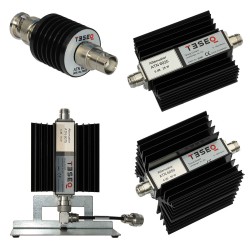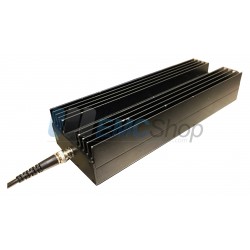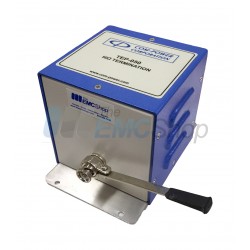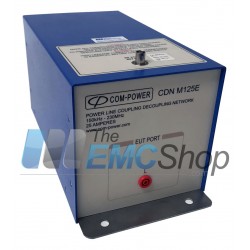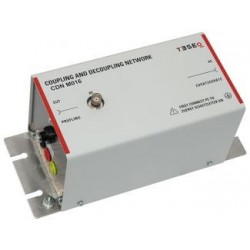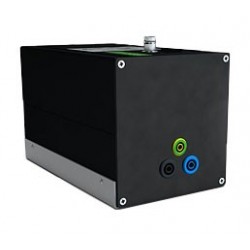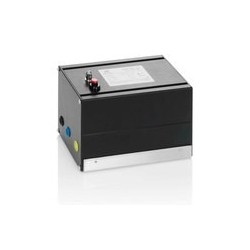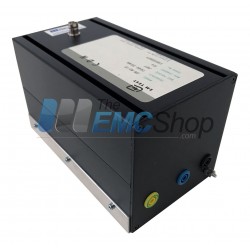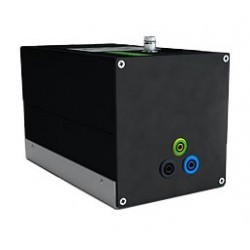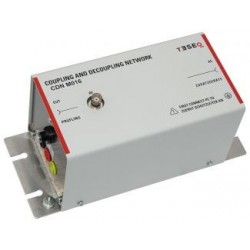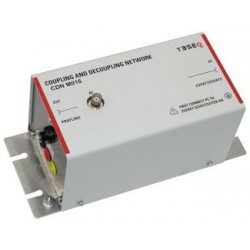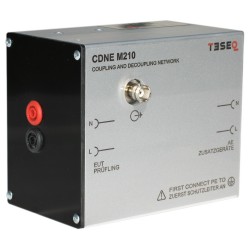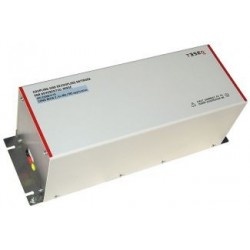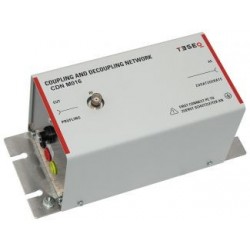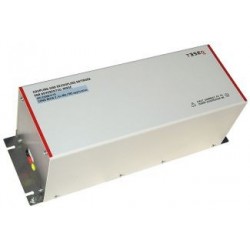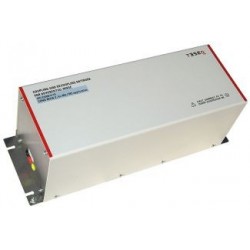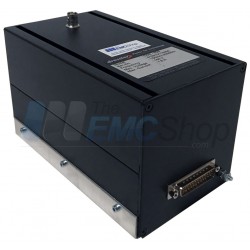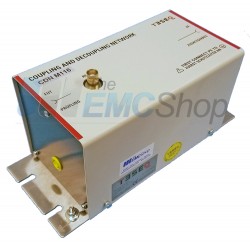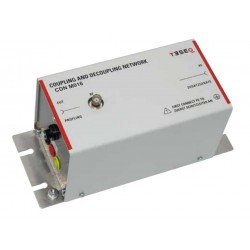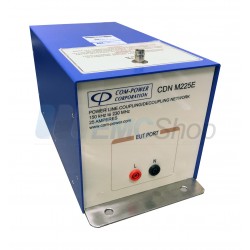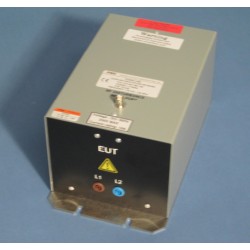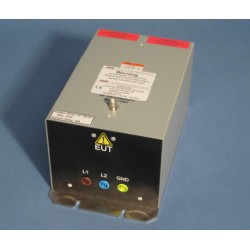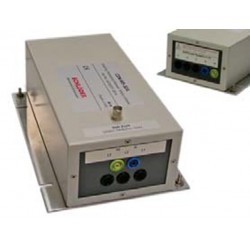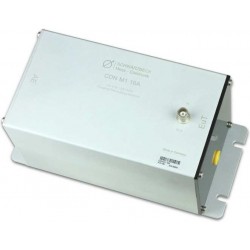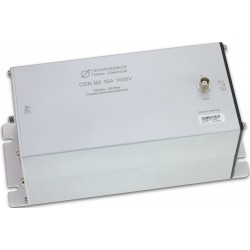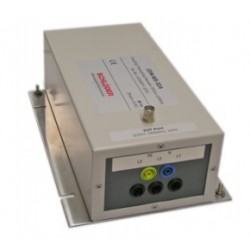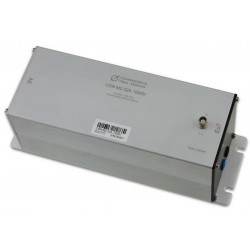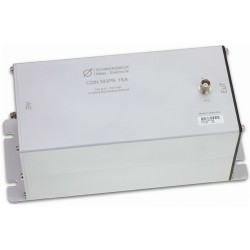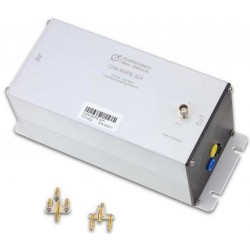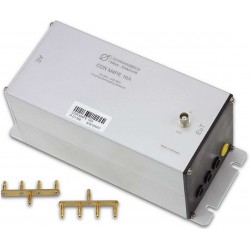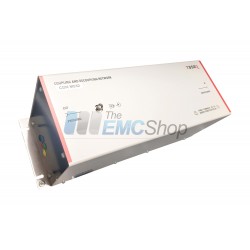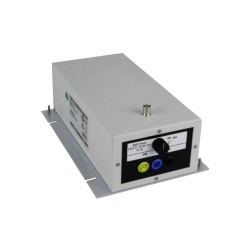No products
Product successfully added to your shopping cart
There are 0 items in your cart. There is 1 item in your cart.
RF Power Line CDN's
- EMC Test Equipment
- Transient Generators
- RF Power Amplifiers
- DC - 300 kHz RF Amplifiers
- 10 kHz - 250 MHz RF Amplifiers
- 10 kHz - 400 MHz RF Amplifiers
- 10 kHz - 1 GHz RF Amplifiers
- 80 MHz - 1 GHz RF Amplifiers
- 1 GHz - 2 GHz RF Amplifiers
- 700 MHz - 4.2 GHz RF Amplifiers
- 1 GHz - 6 GHz RF Amplifiers
- 2 GHz - 8 GHz RF Amplifiers
- 6 GHz - 18 GHz RF Amplifiers
- 18 GHz - 40 GHz RF Amplifiers
- Pulse Amplifiers
- RF Field Strength Probes & Meters
- RF Conducted Immunity
- EMC Receivers/EMI Analyzers
- EMC Antennas
- Coupling Decoupling Networks (CDN's)
- Line Impedance Stabilization Networks (LISN's)
- RF Test Equipment
- EMC Probes
- EMC Measurement & Equipment Software
- Power Supplies
- Electrical Safety Analyzers
- High Precision Laboratory Power Analyzers & Meters
- Anechoic Chambers
- Over-the-Air (OTA) Test Chambers
- EMI RF Shielded Tent Enclosures
- RF Shielded Rooms
- EMC Absorber
- Positioning Equipment
- EMC/EMI Test Setup
- GTEM Cells / TEM Cells
- Reverberation Chambers
- Used RF Anechoic Chambers
- EMC Chamber Filters
- EMC Chamber Shielding Gaskets
- RF Shielded Doors
- Anechoic Chamber Accessories
- Fully Anechoic (FAR) Test Chambers
- Manufacturers
- 3ctest
- AE Techron
- AH Systems
- Amplifier Research
- Boonton
- Com-Power
- Diamond Engineering
- EM Test (Ametek CTS)
- EMC Partner
- EMC Test Design
- Empower High Power RF Amplifiers
- ETS-lindgren
- Log Periodic Dipole Array Antenna
- Near Field Probe Sets
- Double Ridge Horn Antennas
- Biconical Antennas
- Quad Ridge Horn Antennas
- Electric Field Probes
- GTEM's
- Positioners & Tripods
- Loop Antennas
- Biconilog Antennas
- LISN's (Line Impedance Stabilization Network)
- Shielded Enclosures/Rooms
- Monopole Antennas
- Field Generating Antennas
- Fischer Custom Communications
- Haefely Hipotronics
- Haefely EFT/Burst Immunity Test Systems
- Haefely Surge Combination Wave Test Systems
- Haefely Surge Damped Oscillating Wave Test Systems
- Haefely Electrostatic Discharge Test Systems (ESD)
- Haefely Surge Ring Wave Test Systems
- Haefely Surge Telecom Wave Test Systems
- Haefely Magnetic Field Test Systems
- Haefely CDN's (Coupling/Decoupling Networks)
- IFI Amplifiers
- Keysight (Agilent)
- MVG - Microwave Vision Group
- PMM / Narda
- Rohde & Schwarz RF Test Equipment
- Rohde & Schwarz Broadband RF Amplifiers
- Rohde & Schwarz Spectrum Analyzers
- Rohde & Schwarz Compliant EMI Test Receivers
- Rohde & Schwarz Isotropic RF Probes
- Rohde & Schwarz RF Signal Generators
- Rohde & Schwarz RF Switches
- Rohde & Schwarz Oscilloscopes
- Rohde & Schwarz RF Power Meters
- Rohde & Schwarz RF Power Sensors
- Schloder
- Schwarzbeck Mess-Elektronik
- Schwarzbeck Antennas
- Schwarzbeck Automotive Antennas
- Schwarzbeck Broadband Horn Antennas
- Schwarzbeck Biconical Antennas
- Schwarzbeck Logarithmic Periodic Broadband Antennas
- Schwarzbeck Stacked Log-Periodic Broadband Antennas
- Schwarzbeck Biconic Log-Periodic Antennas
- Schwarzbeck Dipole Antennas
- Schwarzbeck Rod Antennas
- Schwarbeck Antenna Baluns / Holders
- Schwarzbeck LISN Line Impedance Stabilisation Networks
- Schwarbeck Decoupling & Absorbing Clamps
- Schwarzbeck Field Probes
- Schwarzbeck Helmholtz Coils
- Schwarzbeck Antenna Masts
- Schwarzbeck Coupling/Decoupling Networks
- Schwarzbeck Antennas
- Solar Electronics
- Teseq (Schaffner)
- Teseq Automotive Transient Generators
- Teseq RF Test Equipment
- Teseq EFT/Burst Generators
- Teseq RF Immunity Generators
- Teseq ESD Guns
- Teseq Surge Generators
- Teseq Harmonics & Flicker Solutions
- Teseq Dips, Interrupts & Variations Equipment
- Teseq Ring Wave Generators
- Teseq Oscillatory Waves Generators
- Teseq Absorbing Clamps / Ferrite Tube
- Teseq EMC Antennas
- Teseq Current Probes
- Teseq Coupling Networks
- Thermo Keytek
- Vicreate
- Compliance Standards
- International (IEC/EN)
- EN/IEC 61000-3-2
- EN/IEC 61000-3-3
- IEC 61000-3-11
- IEC / EN 610000-3-12
- EN/IEC 61000-4-2
- EN/IEC 61000-4-3
- EN/IEC 61000-4-4
- EN/IEC 61000-4-5
- EN/IEC 61000-4-6
- EN/IEC 61000-4-7
- EN/IEC 61000-4-8
- EN/IEC 61000-4-9
- EN/IEC 61000-4-10
- EN/IEC 61000-4-11
- EN/IEC 61000-4-12
- EN/IEC 61000-4-16
- EN/IEC 61000-4-18
- EN/IEC 61000-4-19
- EN/IEC 61000-4-20
- EN/IEC 61000-4-21
- EN/IEC 61000-4-29
- EN/IEC 61000-4-31
- IEC 61000-4-39
- EN/IEC 62132
- SEMI F47 Voltage Sag Immunity
- Product Standards
- Military & Aerospace Standards
- Automotive EMC Standards
- CISPR Standards
- Telecom Testing
- ANSI/IEEE Standards
- FCC Part 15
- FCC Part 30
- International (IEC/EN)
- Application/Test Type
- Radiated Immunity
- Bulk Current Injection Testing
- RF Emissions Testing
- Conducted Immunity
- Conducted Emissions
- Antenna Pattern Measurement
- CE Mark Testing
- Intentional Radiator Testing
- Pulsed HIRF Radar
- Over-the-Air (OTA) Testing
- 5G Test Solutions
- Automotive EMC
- SAR Measurement Equipment
- Radiated Emissions
- Battery Simulator Test Equipment
- Services
- Clearance
Viewed products
-

Teseq CDNE M310...
Frequency range 30 to 300 MHz 520 V,...
-

Used Haefely PIM 150...
PSURGE 8000 Mainframe & PIM 150...
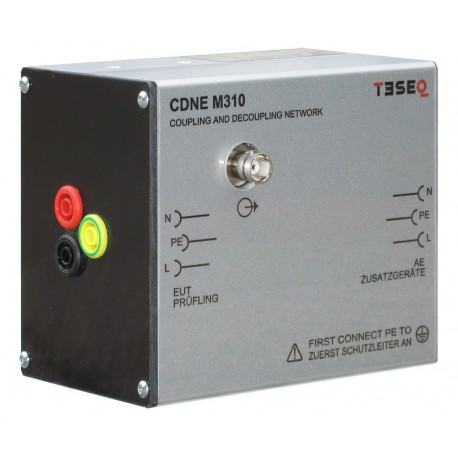 View larger
View larger Teseq CDNE M310 Coupling/Decoupling Network for Emission Measurement, 10 A, 30 to 300 MHz
New
- Frequency range 30 to 300 MHz
- 520 V, 10 Amps, M3 version
- Conforms with CISPR 16-1-2
- Enables testing to CISPR 16-2-1 and CISPR 15 CDN method
- Excellent performance
- Calibration kit available
Typical Lead Time 4 - 6 Weeks
Specifications
| Voltage Rating | C max. voltage (line to ground): 300 V; AC max. voltage (line to line): 520 V; DC max. voltage: 300 V; Tes Voltage: 2000 V AC, 2 s |
| Frequency Range | 30 MHz to 300 MHz |
| Standards Met | CISPR 16-2-1 edition 3.0, CISPR 16-2-1, CISPR 15 and IEC 61000-4-6 |
| RF Connector | BNC, 50 Ω |
| Mains & EUT Connections | 4 mm, safety |
| Common Mode Impedance | Common mode impedance (EUT port): 150 Ω +10/-20 Ω |
| Current Rating | 10 Amps |
| Application/Test Type | Emission measurement (CDNE) to measure disturbance voltages in the 30 to 300 MHz frequency range |
| Insertion Loss | Greater than 0.1 dB |
| RF Input Voltage | Less than 10 Volts |
| Voltage Division Factor | 20 dB ±1.5 dB |
| Decoupling of Common Mode Disturbance | Greater than 30 dB |
| Dimensions | 4.1 x 3 x 5 inches (10.5 x 7.5 x 12.5 cm) |
| Weight | 700 grams (1.5 LB.'s) |
Test Equipment Description
CISPR 16-2-1’s most recent edition 3.0 specifies a new test method which allows the use of a coupling
/ decoupling network for emission measurement (CDNE) to measure disturbance voltages in the
30 to 300 MHz frequency range. This method enables EUTs to be connected directly to the CDNE, allowing
a single conducted emission measurement to replace a lengthy radiated emission test. Product standards
may use this fast, convenient and economical alternative.
CISPR 15 offers an independent method for measurement of radio disturbance characteristics of electrical
lighting equipment. This method specifies the use of a coupling / decoupling network (CDN) as defined
in IEC 61000-4-6 with an extended frequency range 30 to 300 MHz. Using a CDNE as described in CISPR
16-1-2 instead of CDN offers improved measurement reproducibility due to standard’s requirements for
more restrictive limits of asymmetrical impedance, phase angle, symmetrical impedance and internal
attenuation.
The Teseq CDNEs are compliant with the actual versions of CSIPR 16-1-2, CISPR 16-2-1 and CISPR 15’s
CDN method.
Features & specifications of Teseq CDNE M310:
- Frequency range: 30 to 300 MHz
- Power rating (EUT- and AE port)
- AC max. voltage (line to ground): 300 V
- AC max. voltage (line to line): 520 V
- DC max. voltage: 300 V
- Current max: 10 A
- Test voltage: 2000 V AC, 2 s
- Mains sockets (EUT- and AE port): 4 mm, safety
- Common mode impedance (EUT port): 150 Ω +10 / -20 Ω
- Phase angle (EUT port): 0° ±25°
- Differential mode impedance (EUT port): 100 Ω ±20 Ω
- Coupling path (EUT / RF port)
- Connection (RF port): BNC, 50 Ω
- RF voltage (generated from EUT): <10 V
- Transducer factor / Voltage division factor (EUT / RF port)
- incl. internal 10 dB attenuator: 20 dB ±1.5 dB
- Insertion Loss (EUT / AE port), f <400 Hz: >0.1 dB
- Decoupling of CM disturbance (RF port / AE): >30 dB


